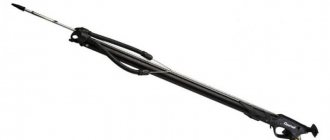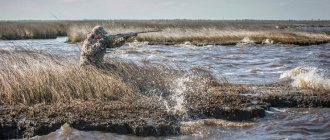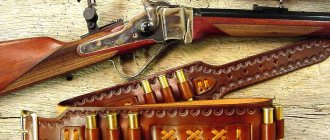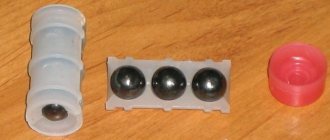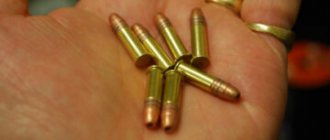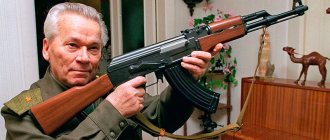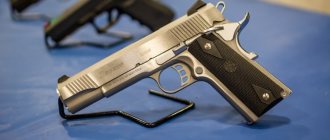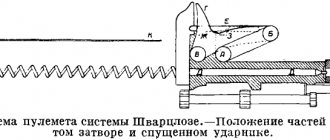The difference between shot and buckshot
Many novice hunters confuse shot with buckshot - another type of ballistic projectile, which is slightly larger in size. If you put several lead bullets of small caliber (4.5 mm) in your hand, they will also resemble large pellets.
Matched buckshot rolled in a wad container 12 gauge
In order not to confuse anything, you need to know the differences and purposes of the main types of damaging elements in the cartridge:
- Shot is a small lead ball (from 1.25 to 5 millimeters in diameter), which is intended only for smooth-bore weapons. It is used mainly for shooting wild birds and nimble fur-bearing animals. Classified by numbers from 0000 to 12. The higher the number, the smaller the diameter of the shot - not to be confused with gauge (12, 16, 20, and so on).
- Buckshot - larger lead balls than shot (from 5.25 to 10 millimeters), used for shooting large animals: bears, wild boars, moose, and so on. The numbers are exactly the same as those of a fraction, but differ in the prefix “K” at the beginning. There is also a type of artillery grapeshot that is used to fill howitzers and mortars.
- A bullet is another type of ballistic projectile that can be used in both smooth-bore and rifled weapons. The main difference from shot and buckshot is that the hunter fills the cartridge with only one striking element. Bullets have the largest diameter, as well as the greatest accuracy when shooting.
Solid cast hunting shot No. 4
When choosing a ballistic projectile, it is not the shooting of a specific animal that is taken into account, but from what distance the shooting will be done. For example, due to the high accuracy of combat, a bullet can hit the target accurately even when fired from a distance of several hundred meters. The shot will simply scatter in different directions already at a distance of 70 m or more.
Diameter of shot of different numbers, mm.
When loading cartridges with shot, serious attention must be paid to its quality, since it has a noticeable effect on the pellet of the shot shell. The pellets must have the correct spherical shape and more or less the same diameter.
The more individual pellets approach the ideal shape of a ball and the less they are deformed as they pass through the bore during a shot, the better the quality of the shot. Shots that are more uniform in size give less elongation of the shot sheaf when fired.
Types of fractions
Shot is used for hunting a wide variety of animals: capercaillie, wolf, hare, black grouse, duck, squirrel, wild boar. So it would be strange if the same ballistic projectile was suitable for shooting both a predator and a small fur-bearing animal. Therefore, there are many types of shot, and for ease of selection, a ballistic projectile is classified according to the type of material, as well as the diameter of the ball.
Material
The main types of shot are made of metal, differing in different masses and deformation rates. Some ammunition can only be used when fired from a certain weapon, for example, hot shot will tear apart any barrel that is made of carbon steel. Here are the main varieties that are popular among hunters:
- Lead shot. The most common and cheapest type of ballistic projectile. Due to the fact that fairly light and soft metal is used in production, such shot is suitable for shooting only small animals and birds.
- Steel shot. To manufacture this damaging element, carbon steel is used, which is characterized by good strength and high weight. The shot power of such a cartridge is lethal, but the pellets can cause damage to the bores.
- Hot shot. It differs from the lead variety only in that the balls undergo a cold hardening procedure. Such a ballistic projectile is only suitable for strong barrels, and the speed of the shot is quite enough to kill a grizzly bear.
Copper-coated lead hunting shot No. 1
There is also clad shot - the most expensive, but the best (in terms of characteristics) type of ballistic projectile. Such balls are made of lead, but are coated with a layer of nickel, which is why they weigh quite little, but have impressive destructive power.
Shot diameter by numbers
The larger the diameter of the ballistic projectile, the less lead ammunition will fit into the cartridge, but the higher the accuracy and power of the shot will be. Large shot is used mainly for shooting large mammals, while small shot is suitable for hunting birds. The table lists the size by number (the indicators are relevant for those cartridges that are manufactured in Russia):
| Fraction number | Shot diameter (mm) |
| 12 | 1,25 |
| 11 | 1,50 |
| 10 | 1,75 |
| 9 | 2,00 |
| 8 | 2,25 |
| 7 | 2,40 |
| 6 | 2,75 |
| 5 | 3,00 |
| 4 | 3,25 |
| 3 | 3,50 |
| 2 | 3,75 |
| 1 | 4,00 |
| 0 | 4,25 |
| 00 | 4,50 |
| 000 | 4,75 |
| 0000 | 5,00 |
The marking of cartridges in the rest of the world is slightly different from Russian products, but the main indicators remain the same. Here are the pellet numbers and their diameter:
| Fraction number | Shot diameter (mm) |
| 12 | 1,25 |
| 11 | 1,50 |
| 10 | 1,75 |
| 9 | 2,00 |
| 8 | 2,25 |
| 7 | 2,40 |
| 6 | 2,75 |
| 5 | 3,00 |
| 4 | 3,25 |
| 3 | 3,50 |
| 2 | 3,75 |
| 1 | 4,00 |
| 0 | 4,25 |
| BB | 4,50 |
| BBB | 4,75 |
| T or O | 5,00 |
Thus, the lower the number of the shot, the larger the animal it is used for. For example, No. 0000 is suitable for shooting young deer and elk, but the destructive power of No. 12 is hardly enough to shoot down a quail. Although the size of the prey is far from the only indicator that should be taken into account.
Types of cartridges and shot numbers for 12 gauge
Each hunter himself selects for himself the numbers of fractions convenient for hunting a particular animal or bird. Some people shoot at a goose with shot number 1, since it hits the head, while others use shot number 00, since it is more difficult to penetrate the dense feathers on the chest with one.
When choosing a shot, you also need to take into account the seasonality of hunting. In winter, the animal's plumage or fur is denser, making it difficult to penetrate. The usual distance to the target is approximately 35-40 meters.
| Fraction number | Diameter, mm | On whom |
| 12 (small) | 1,25 | Quail, snipe, snipe and other small birds |
| 11 (small) | 1,50 | |
| 10 (small) | 1,75 | |
| 9 (small) | 2 | |
| 8 (small) | 2,25 | |
| 7 (small) | 2,50 | Ducks, pheasants and other larger birds, teals |
| 6 (small) | 2,75 | |
| 5 (small) | 3 | |
| 4 (average) | 3,25 | Can be used on goose, hare, black grouse |
| 3 (average) | 3,50 | |
| 2 (average) | 3,75 | |
| 1(medium) | 4 | Hare, goose, fox, wood grouse. |
| 0 (large) | 4,25 | |
| 00 (large) | 4,50 | Larger animals such as roe deer, lynx, etc. Can be used on hare, goose |
| 000 (large) | 4,75 | |
| 0000 (large) | 5 |
The table shows the numbers of fractions, their diameter and who they are used for. The fraction pitch is 0.25 mm. As can already be seen, the higher the number of the fraction, the finer it is.
Fraction by type of game
Let's assume that the hunter manages to shoot a shot of number twelve at a hare and kill it (for example, by increasing the amount of gunpowder). In this case, the wounded wound will leave a lot of holes and a sea of blood. The trophy value of the skin will completely disappear, and several dozen lead balls will have to be picked out of the meat. Therefore, it is recommended to use certain shot numbers only for shooting specific animals:
| Type of game | Fraction number |
| Wolves, roe deer, deer, wild boars, moose and other large animals, except bears | 00, 000 and 0000 |
| Hares, foxes, squirrels and other small fur-bearing animals and mammals | 2, 1 and 0 |
| Black grouse, wood grouse, ducks, geese and other large birds | 6, 5, 4 and 3 |
| Partridges, chirches, hazel grouse, woodcocks and other varieties of medium-sized birds | 8 and 7 |
| Great snipes, waders, snipes, quails and other small species of birds | 11, 10 and 9 |
As for larger animals, it is best to use buckshot to shoot them. If a hunter plans to kill a sparrow or other type of small bird with shot, then a ballistic projectile number 12 will come in handy.
Lead shot No. 10 for small game birds
Dependence on the time of year
The size of the prey may vary throughout the year. Closer to winter, most birds and mammals begin to develop plumage and fluff, which makes it difficult for pellets to penetrate. So a ballistic projectile that was used in the spring may not be as effective when hunting in late fall. That is why when choosing a fraction you should take into account the time of year:
- In winter, the recommended fraction number can be increased by one unit. That is, if a ball of zero number was usually used to shoot a fox, then it should be replaced with the first, since animals lose most of their weight during cold weather.
- In spring, most animals reach their minimum weight for the entire season, so the shot number should be chosen 1-2 less than in autumn or summer. This is especially true for game birds that return from warmer climes.
- In the summer, the hunter can safely use the shot numbers listed in the tables in the previous section, since the weight of the animal remains within the normal range during all three months.
- In the fall, many birds and mammals gain weight, so to shoot them you will have to get a larger shot, that is, reduce the number by a couple of units, for example, switch from three to one.
Choosing a fraction depending on the time of year
These recommendations are conditional, since much depends on the specific animal and in what month it begins to gain fat. In most cases, these tips work, so novice hunters can safely use them.
Types of cartridges and shot numbers for 12 gauge
Each hunter himself selects for himself the numbers of fractions convenient for hunting a particular animal or bird. Some people shoot at a goose with shot number 1, since it hits the head, while others use shot number 00, since it is more difficult to penetrate the dense feathers on the chest with one.
When choosing a shot, you also need to take into account the seasonality of hunting. In winter, the animal's plumage or fur is denser, making it difficult to penetrate. The usual distance to the target is approximately 35-40 meters.
| Fraction number | Diameter, mm | On whom |
| 12 (small) | 1,25 | Quail, snipe, snipe and other small birds |
| 11 (small) | 1,50 | |
| 10 (small) | 1,75 | |
| 9 (small) | 2 | |
| 8 (small) | 2,25 | |
| 7 (small) | 2,50 | Ducks, pheasants and other larger birds, teals |
| 6 (small) | 2,75 | |
| 5 (small) | 3 | |
| 4 (average) | 3,25 | Can be used on goose, hare, black grouse |
| 3 (average) | 3,50 | |
| 2 (average) | 3,75 | |
| 1(medium) | 4 | Hare, goose, fox, wood grouse. |
| 0 (large) | 4,25 | |
| 00 (large) | 4,50 | Larger animals such as roe deer, lynx, etc. Can be used on hare, goose |
| 000 (large) | 4,75 | |
| 0000 (large) | 5 |
The table shows the numbers of fractions, their diameter and who they are used for. The fraction pitch is 0.25 mm. As can already be seen, the higher the number of the fraction, the finer it is.
How to increase shot accuracy
Low accuracy rate is one of the main problems faced by hunters who use shotguns to shoot animals and birds. You can increase this parameter in three main ways:
- Reduce the number of pellets in the cartridge and increase the powder weight.
- Reduce the distance to the target if possible.
- Choose the fraction with the smaller number.
12 gauge capsule shotshells
You can also use capsule cartridges, in which the pellets are in special plastic containers that partially burn at the moment of firing. But this cartridge is not very well suited for hunting, where a large spread of shot is needed, for example, when shooting birds.
Number of pellets in the cartridge
Many hunters also argue about the optimal number of pellets in a cartridge. They say that if the gunpowder is properly pressed, then the cartridge case will accommodate much more damaging elements, which will increase the chances of a hit. In fact, the number of pellets depends on the number of the shot - a couple of dozen balls will fit into one cartridge, up to 40 balls into another. Beginning hunters can use a special table to select a consistent shot:
| Fraction number | 12 gauge | 16 gauge | 20 gauge |
| № 8 | 490 pcs | 400 pcs | 314 pcs |
| № 7 | 364 pcs | 311 pcs | 244 pcs |
| № 6 | 276 pcs | 233 pcs | 183 pcs |
| № 5 | 217 pcs | 175 pcs | 137 pcs |
| № 4 | 168 pcs | 140 pcs | 110 pcs |
| № 3 | 140 pcs | 112 pcs | 88 pcs |
| № 2 | 111 pcs | 90 pcs | 70 pcs |
| № 1 | 87 pcs | 70 pcs | 55 pcs |
| № 0 | 73 pcs | 59 pcs | 46 pcs |
| № 00 | 63 pcs | 50 pcs | 40 pcs |
| № 000 | 53 pcs | 43 pcs | 34 pcs |
| № 0000 | 47 pcs | 37 pcs | 29 pcs |
Now regarding what caliber is used to shoot a particular game:
- 20 gauge - suitable for hunting most small to medium sized birds;
- 16 gauge is the “golden mean”, suitable for hunting both birds and fur-bearing animals;
- 12 gauge - suitable for shooting mammals and only large birds.
Hunting cartridges Clever 20 caliber shot 4 Magnum
How to make fractions yourself
To make shot with your own hands, you will need to acquire a sufficient amount of lead, as well as a special “colander” in which the molten metal will take the form of drops. Here are more detailed instructions:
- We heat the lead in a cast iron or steel thicket until it becomes liquid.
- Pour the molten metal into a colander and close the lid properly.
- Place the tool in a barrel of cold water for 5 minutes.
After this, all that remains is to remove the pellets from the “colander” and clean them of excess burrs. Homemade ammunition is inferior in quality to store ammunition, but can also be used for fishing.
The shot can serve as a universal ballistic projectile for hunting. The most important thing is to choose the optimal diameter of the striking element and the best shooting distance.
Self-production
You can make shot at home yourself, but it’s easier to buy it in a store.
Specialized stores sell a huge number of types of shot. Almost all of them were created by stamping. This fact does not suit all hunters. Today you can find adherents of the old methods of making ammunition. They prefer to do this business themselves rather than buy a ready-made shell for a cartridge.
Avoiding purchased shot can save hunters money. Making it yourself is considered a less expensive option.
The master himself decides what type (type) of fraction to choose and how to make it. The most preferred method is to cast ammunition at home. There are several ways to carry out this work. One of them requires the following steps:
- Initially, the master must make a shotgun die. It looks like metal bars, complemented by comfortable handles.
- Holes must be drilled in each piece of metal. In size they must correspond to the diameter of the desired shot. The range goes from the second size to the buckshot parameter.
- The holes must be connected to each other by common grooves. They go up into a groove and have a cross-cutting structure.
- Lead must be poured into the groove.
- Next, you need to cut off the remaining material with scissors used for cutting metal.
- All that remains is to roll the ammunition in the shot mill. You can skip this step if you wish. Although experts recommend not to neglect it, since rolled shot has a more regular shape.
